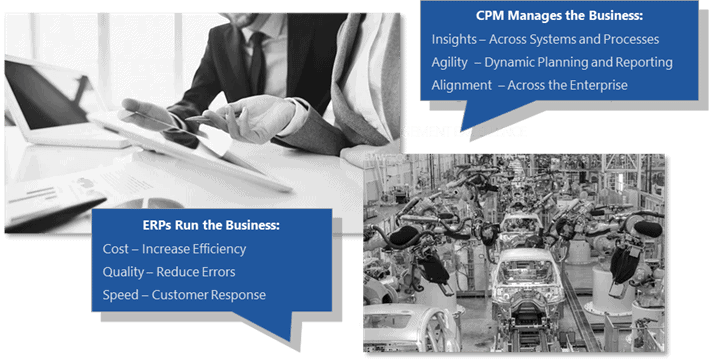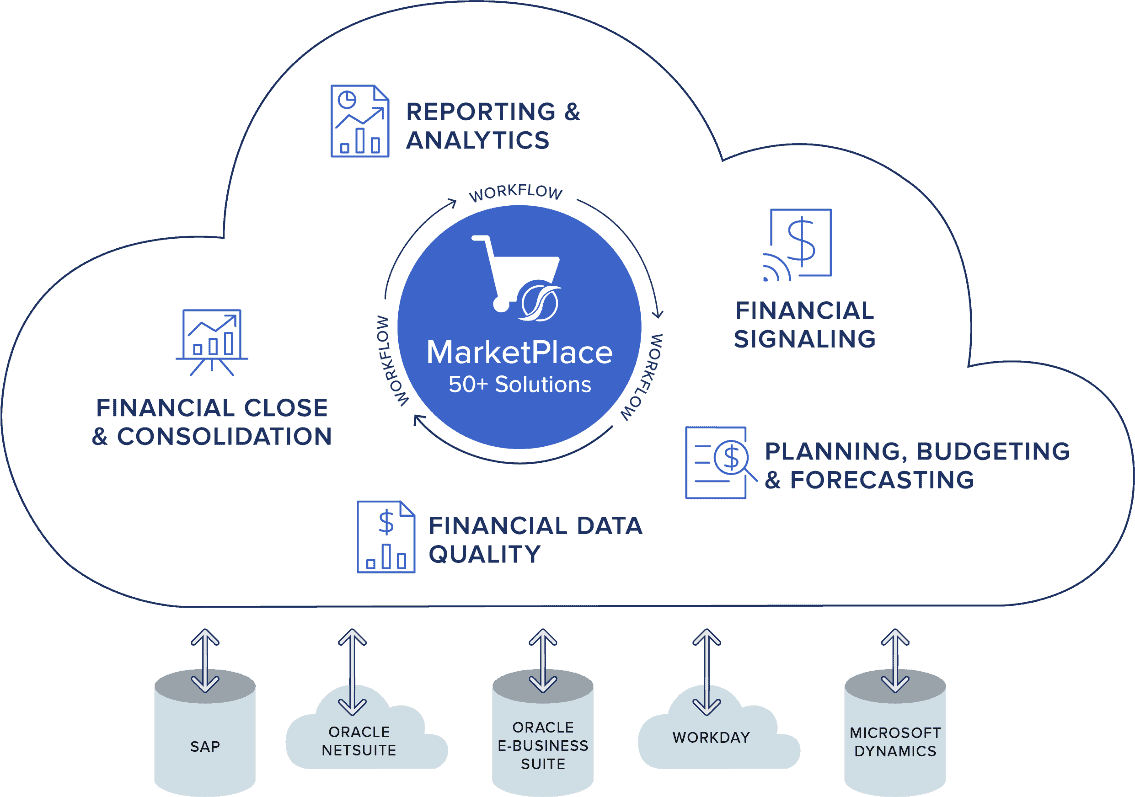Like all things that change over time, the corporate performance management (CPM) or enterprise performance management (EPM) landscape has been through several key changes. Many of you may remember the consolidation of smaller niche vendors nearly 15 years ago when OutlookSoft, Cartesis, Hyperion, Cognos and TM1, to name a few, were swallowed up by those mega-vendors of today – SAP, Oracle and IBM. The critical importance of CPM in Finance Transformation continues to grow.
With increasing market demand for Finance Transformation, newer CPM vendors have since flourished alongside continual market growth and increasingly more organisations recognising the need for such solutions. Indeed, the mega-vendors now have multiple areas of focus, outside of CPM, and have probably found themselves with declining CPM businesses, which only contribute a small percentage of mega-vendors’ overall revenues.
Not surprisingly, then, there is a natural push from legacy vendors to divert focus and attention towards full enterprise resource planning (ERP), human capital management (HCM), customer experience and/or supply chain opportunities to drive higher revenue and secure more of those larger deals. But there is a problem with that. Sometimes this approach dilutes the value of CPM, which is definitely not ideal.
De-Emphasising CPM Dilutes Finance Transformation
De-emphasising CPM ultimately has a negative effect. The result? The dilution of Finance Transformation. Specifically, what has transpired is the collapse of the lines between ERP and CPM businesses as a result of reallocating investments away from delivering true innovation. Instead, the focus has been on aligning the look and feel of the ERP and CPM solutions, creating a perception that CPM and ERP are the same, or at least interchangeable.
Legacy vendors are also willing to further dilute the value of CPM/EPM by heavily discounting CPM into multi-million-dollar ERP, HCM and supply chain software deals. While this approach might work for IT groups intent on using a single vendor, potential consequences abound. Here are just a few ways de-emphasising CPM impacts Finance teams:
- Non-technical Finance teams and often IT may not understand the key differences between ERP and CPM solutions.
- ERP investments may get prioritized over CPM, adding years of implementation and change management before any “new” transformation is even delivered to already-taxed Finance teams.
- IT groups may force Finance teams to compromise their requirements with unproven, fragmented CPM tools – adding risk, cost and complexity into key CPM process right when Finance teams must conquer complexity.
While preparing for the next step in the transformation journey, Finance leaders must, must, must understand the key differences between ERP and CPM. And for organizations preparing to evaluate new software for Finance Transformation, understanding ERP and CPM is especially critical.
ERP Systems Run the Business
Transactional systems such as ERP are best used to ‘run’ the organisation. Any number of these systems can be present in a global organisation and can come from multiple suppliers.
While the term was first used in the 1990s by the Gartner Group, ERP systems actually have deep roots in the manufacturing industry and can trace their history back to the 1960s. At that time, manufacturers needed a better way to manage, track and control inventory.
Today, ERP is generally referred to as a category of business management software – and typically a suite of integrated applications – that an organization can use to collect, store, manage and interpret data from many business activities. Here are some examples of the business activities ERP systems help automate and track:
- Manufacturing
- Supply Chain Management
- Project Management
- Order Processing
- Finance and Accounting (e.g., General Ledger, Fixed Assets, Accounts Payable, Accounts Receivable, Cash Management)
CPM Systems Manage the Business
The CPM or EPM solution (see Figure 1) is the management layer above all transaction systems. CPM software provides a level of agility and visibility which is now critical for any organisation that wants to successfully handle the complexities of growth and change. With an effective management layer in place, organisations can upgrade or replace underlying ERP/GL systems. And it can be done without disrupting critical management processes, such as planning and reporting, during the transition period.

Essentially, CPM systems monitor performance across the enterprise with a key goal at the centre of it all: improving business performance. A CPM system integrates and analyses data from many sources, including from applications across the organization such as the front-office, e-commerce systems, back-office, data warehouses and external data sources. Here are a few of the key management processes supported by CPM:
- Strategic Planning
- Budgeting, Planning and Forecasting
- Analytics and Scenario Modelling
- Financial Close and Consolidation
- Profitability Management
- Corporate Tax Provisioning and Reporting
- Statutory and Management Reporting
CPM Investments Are Agnostic to M&A Strategy
During a recent customer conversation, the customer explained how a OneStream CPM investment was a key part of his organisation’s M&A strategy. The company recently made a very large acquisition and had very little time or information to integrate the financial systems. To integrate or consolidate systems at the transactional ERP layer would take months or even years, not to mention cause major disruptions in day-to-day business operations. Comparatively, integrating the acquired company into OneStream can take just a matter of hours to a few days depending on the company size.
The Next Generation CPM Emerges
OneStream entered the CPM market to offer something completely different to the fragmented CPM systems acquired and developed by mega-vendors. To offer something better – a single unified platform to bring together all the key CPM processes and analytics in one place (see Figure 2).
The strength of the OneStream platform takes organisations to an entirely new level of CPM, one where they can move away from only viewing key data and ratios at the month end to receiving weekly or even daily signals. As a result, action can be taken at the speed of the organisation. OneStream is therefore empowering its customers to “lead at speed.”
With OneStream, multiple integrations down to source systems to feed each CPM process are not necessary. Instead, the intuitive workflow ensures data is loaded from ERPs only once and then becomes immediately available in any required process, such as planning and financial consolidation.

Thanks to OneStream’s ability to re-use core components of dimensionality, different hierarchies/business structures – which previously often resulted in separate CPM instances – can now be accommodated in a single platform.
That’s why over 700 organisations have chosen to convert from multiple legacy CPM products to OneStream’s Intelligent Finance platform – and they’ve never looked back. These organisations have achieved abundant benefits. Here are just a few:
- Eliminated the risk and complexity of data integration, validation and reconciliation between multiple products, applications or modules.
- Transformed Finance and shifted Finance users’ time from admin to value-added analysis.
- Supported corporate and multiple line-of-business requirements in a single, unified platform.
Conclusion
When it comes to CPM vs. ERP, leaving CPM behind for an ERP system is not a great move for any medium to large organisation. A CPM solution is a critical investment for such organisations – one that ensures an effective management layer is in place. CPM solutions deliver key information and reporting relating not only to the performance of the business but also to how to manage effectively and take the right decisions going forward. In other words, CPM complements and integrates with transactional systems such as ERPs, which are key to running the business – true Finance Transformation relies on both CPM and ERP systems working together.
Learn More
To learn more, click here to read about how our customer Xylem facilitates better, faster business decisions using OneStream.
Get Started With a Personal Demo



